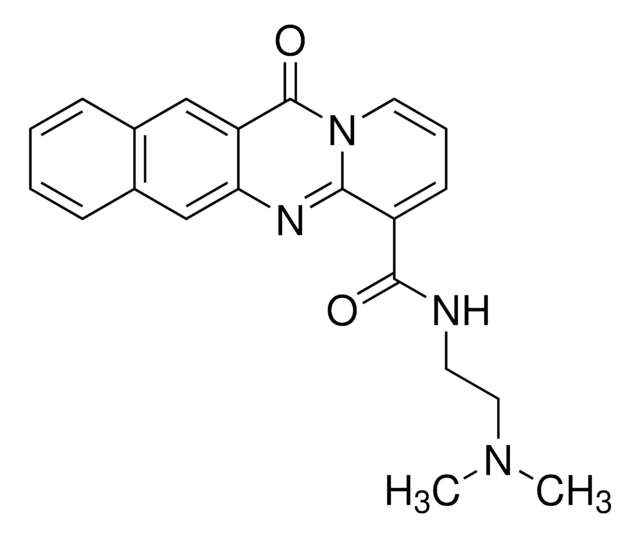557403
RNA-Polymerase III-Inhibitor
RNA Polymerase III Inhibitor, CAS 577784-91-9, is a cell-permeable inhibitor of RNA Polymerase III (IC₅₀ = 27 and 32 µM for human and S. cerevisiae RNA Pol III, respectively).
Synonym(e):
RNA-Polymerase III-Inhibitor, ML-60218, N-[1-(3-(5-Chlor-3-methylbenzo[b]thiophen-2-yl-1-methyl-1H-pyrazol-5-yl)]-2-chlorobenzolsulfonamid
About This Item
Empfohlene Produkte
Qualitätsniveau
Assay
≥95% (HPLC)
Form
solid
Hersteller/Markenname
Calbiochem®
Lagerbedingungen
OK to freeze
protect from light
Farbe
off-white
Löslichkeit
DMSO: 15 mg/mL
Versandbedingung
ambient
Lagertemp.
2-8°C
InChI
1S/C19H15Cl2N3O2S2/c1-11-13-9-12(20)7-8-16(13)27-19(11)15-10-18(24(2)22-15)23-28(25,26)17-6-4-3-5-14(17)21/h3-10,23H,1-2H3
InChIKey
BVBDTTLISMIOJY-UHFFFAOYSA-N
Allgemeine Beschreibung
Biochem./physiol. Wirkung
Aktivität gegen RNA-Polymerase III
Verpackung
Warnhinweis
Angaben zur Herstellung
Rekonstituierung
Sonstige Hinweise
Rechtliche Hinweise
Lagerklassenschlüssel
11 - Combustible Solids
WGK
WGK 1
Flammpunkt (°F)
Not applicable
Flammpunkt (°C)
Not applicable
Analysenzertifikate (COA)
Suchen Sie nach Analysenzertifikate (COA), indem Sie die Lot-/Chargennummer des Produkts eingeben. Lot- und Chargennummern sind auf dem Produktetikett hinter den Wörtern ‘Lot’ oder ‘Batch’ (Lot oder Charge) zu finden.
Besitzen Sie dieses Produkt bereits?
In der Dokumentenbibliothek finden Sie die Dokumentation zu den Produkten, die Sie kürzlich erworben haben.
Unser Team von Wissenschaftlern verfügt über Erfahrung in allen Forschungsbereichen einschließlich Life Science, Materialwissenschaften, chemischer Synthese, Chromatographie, Analytik und vielen mehr..
Setzen Sie sich mit dem technischen Dienst in Verbindung.







![Digoxigenin-11-dUTP, alkalilabil =85% (HPLC), solution, pkg of 25 μL (11573152910 [1 mM]), pkg of 125 μL (11573179910 [1 mM]]])](/deepweb/assets/sigmaaldrich/product/images/352/091/ef743cea-ccd8-44f1-8f3b-dec5a1e4f5d1/640/ef743cea-ccd8-44f1-8f3b-dec5a1e4f5d1.jpg)
